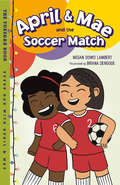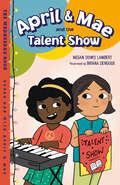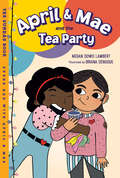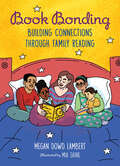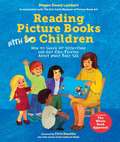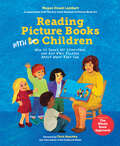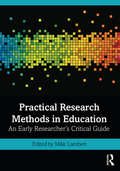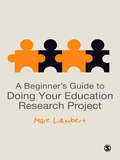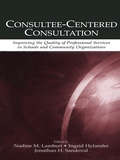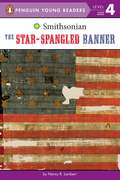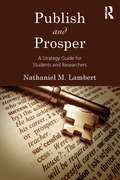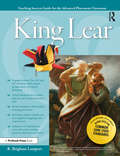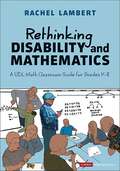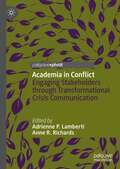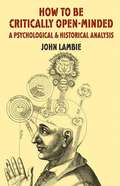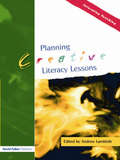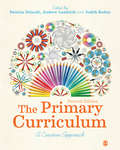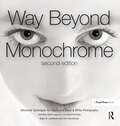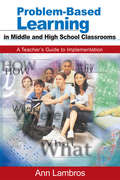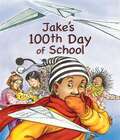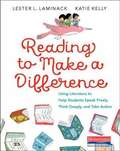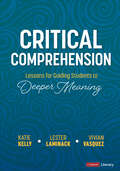- Table View
- List View
April & Mae and the Soccer Match: The Tuesday Book (Every Day with April & Mae #3)
by Megan Dowd LambertFans of King & Kayla and Charlie & Mouse will love this delightful beginning chapter book series that celebrates friendship every day of the week!It&’s Tuesday, at the soccer game! April likes to play soccer, and Mae likes to win. When a slip in the mud causes Mae to miss the winning goal, she's frustrated. But best friend April helps Mae see that one loss doesn&’t make her bad at soccer and reminds her that playing with friends is just as fun as winning. With imagination and humor, Every Day with April and Mae brings all there is to know and love about friendship to life in a way kids can both relate to and learn from making this a perfect fit for young readers ready to step up from picture books.
April & Mae and the Talent Show: The Wednesday Book (Every Day with April & Mae #4)
by Megan Dowd LambertFans of King & Kayla and Charlie & Mouse will love this delightful beginning chapter book series that celebrates friendship every day of the week!It&’s Wednesday, and the library is holding a talent show to raise money for new books. April and Mae want to help. April decides to perform, but Mae prefers to help behind the scenes. When April gets nervous on the day of the show, Mae's support is all she needs to overcome her fears! With imagination and humor, Every Day with April and Mae brings all there is to know and love about friendship to life in a way kids can both relate to and learn from making this a perfect fit for young readers ready to step up from picture books.
April & Mae and the Tea Party: The Sunday Book (Every Day with April & Mae #1)
by Megan Dowd LambertFans of King & Kayla and Charlie and Mouse will love this delightful beginning chapter book series that celebrates friendship every day of the week!It's Sunday, and April and Mae are having their weekly tea party. Mae usually bakes goodies, and April always sings and dances. But this Sunday, April decides to try a new activity. When April's juggling causes her to break Mae's favorite teacup, the two friends navigate their first disagreement and eventually apologize and forgive each other. With imagination and humor, Every Day with April and Mae brings all there is to know and love about friendship to life in a way kids can both relate to and learn from making this a perfect fit for young readers ready to step up from picture books.
Book Bonding: Building Connections Through Family Reading
by Megan Dowd LambertA collection of essays about family, reading, and bonding with others through books. From children&’s literature educator and children&’s book author Megan Dowd Lambert.This poignant, funny, and touching essay collection invites readers to consider how they bond with children, other family, friends, and students through shared reading. Divided into 4 sections organized around themes of parenting, adoption, race, and healing, this 21-essay collection with its joyous and colorful illustrations is perfect gift for parents, grandparents, librarians, educators, and anyone who spends time with children or reading together with others. The author's experience as an educator and as a parent in a blended family that includes seven children of various racial backgrounds (four of whom came home through adoption) adds depth and breadth to her expertise about how people read and respond to books. "I grew up with a mother who loved to read, and what a sustaining gift that has been to me. If you are holding this book, it&’s a good bet that you love to read, too. Read on, and let Megan show you how to make your love for books and your love for the children in your life add up to something special."--Roger Sutton, Editor Emeritus, The Horn Book, Inc., from Book Bonding's foreword
Reading Picture Books with Children
by Megan Dowd LambertA new, interactive approach to storytime, The Whole Book Approach was developed in conjunction with the Eric Carle Museum of Picture Book Art and expert author Megan Dowd Lambert's graduate work in children's literature at Simmons College, offering a practical guide for reshaping storytime and getting kids to think with their eyes. Traditional storytime often offers a passive experience for kids, but the Whole Book approach asks the youngest of readers to ponder all aspects of a picture book and to use their critical thinking skills. Using classic examples, Megan asks kids to think about why the trim size of Ludwig Bemelman's Madeline is so generous, or why the typeset in David Wiesner's Caldecott winner,The Three Pigs, appears to twist around the page, or why books like Chris Van Allsburg's The Polar Express and Eric Carle's The Very Hungry Caterpillar are printed landscape instead of portrait. The dynamic discussions that result from this shared reading style range from the profound to the hilarious and will inspire adults to make children's responses to text, art, and design an essential part of storytime.
Reading Picture Books with Children: How to Shake Up Storytime and Get Kids Talking about What They See
by Megan Dowd LambertA new, interactive approach to storytime, The Whole Book Approach was developed in conjunction with the Eric Carle Museum of Picture Book Art and expert author Megan Dowd Lambert's graduate work in children's literature at Simmons College, offering a practical guide for reshaping storytime and getting kids to think with their eyes. Traditional storytime often offers a passive experience for kids, but the Whole Book approach asks the youngest of readers to ponder all aspects of a picture book and to use their critical thinking skills. Using classic examples, Megan asks kids to think about why the trim size of Ludwig Bemelman's Madeline is so generous, or why the typeset in David Wiesner's Caldecott winner,The Three Pigs, appears to twist around the page, or why books like Chris Van Allsburg's The Polar Express and Eric Carle's The Very Hungry Caterpillar are printed landscape instead of portrait. The dynamic discussions that result from this shared reading style range from the profound to the hilarious and will inspire adults to make children's responses to text, art, and design an essential part of storytime.
Practical Research Methods in Education: An Early Researcher's Critical Guide
by Mike LambertPractical Research Methods in Education is a hands-on guide which critically explores and scrutinizes research methods used in educational enquiry. Drawing on the research, practical experience and reflections of active researchers, each chapter offers explanations, examples, tasks for students to undertake and suggestions for further reading, all of which are designed to strengthen understanding of practical methods of data collection in educational and social-science research. This insightful book offers: Detailed illustration of a range of data-collection methods and approaches used in educational research Chapters written by active researchers, experienced in addressing challenges of carrying out practical research in education Examples, study tasks and suggestions for further reading in each chapter An exploration of critical reflection and decision-making in relation to research methodology in education Close attention to research ethics Exploring practical methods of data-collection for educational and social-science research, Practical Research Methods in Education is a unique and valuable resource for any students interested and engaged in the planning and completion of their own investigations.
A Beginner's Guide to Doing Your Education Research Project
by Mr Mike Lambert'Mike Lambert's book is a useful source of information, helping to create and shape your research methods project. The book contains detailed chapters with easy to follow guidelines, tips and suggestions ensuring help at every step of the way from start to finish'Alexander Miesen, student, Amsterdam University of Applied Sciences In this basic guide, step-by-step advice is presented in a clear way and chapters take the reader through the entire process, from planning and doing research, to writing it up. Each stage is covered, with detailed help on choosing a topic, drawing up research questions, doing the literature review, choosing and designing research methods, the ethics of doing research, analyzing data, and collating and presenting findings. Features in the text include: - explanations of key research terms - activities (with answers) - progress sheets - case studies Online resources to accompany the book are available at www.methodspace.com/groups/mikelambert This is an ideal text for undergraduate students undertaking their first ever research project, postgraduates pursuing Masters awards and teachers carrying out action research.
Consultee-Centered Consultation: Improving the Quality of Professional Services in Schools and Community Organizations (Consultation, Supervision, and Professional Learning in School Psychology Series)
by Nadine M. Lambert Ingrid Hylander Jonathan H. SandovalThis book describes the theory, methods, and contemporary applications of consultee-centered consultation, a non-hierarchical, non-prescriptive helping relationship between a consultant and a person or group (consultee) seeking professional help with a client. The goal is to provide help in re-conceptualizing the consultee's work problem thereby 1) improving their relationship with the client and 2) expanding the professional repertoire of both consultant and consultee. Key features of this outstanding new book include the following:*Conceptual Change Focus--The process of conceptual change in both the consultant and consultee is stressed throughout the book.*Historical Perspectives--The first section describes the historical evolution of consultee-centered consultation beginning with the work of Gerald Caplan and progressing to its broad, contemporary version that accommodates various professions and multiple psychological orientations.*Numerous Examples--The book provides a wealth of examples illustrating how consultee-centered consultation can be applied within school, child-care, social welfare, hospital and corporate settings.*International Focus--The chapter contributors represent a wide range of geographical and professional expertise.*Evaluation Methods--The final section provides examples of evaluation methods.This volume is appropriate for school, counseling, and clinical and child clinical psychologists; human service professionals working with professionals from other disciplines; and special education leaders.
The Star-Spangled Banner (Smithsonian)
by Nancy R. LambertThree cheers for the red-white-and-blue in this Smithsonian nonfiction reader!The original Star-Spangled Banner that flew over Fort McHenry, Baltimore, in 1814 and inspired Francis Scott Key to write the words that would become the national anthem of the United States is the showpiece of the Smithsonian! In this lively nonfiction book, young readers will read about the story behind the flag, the song, and how the Smithsonian cares for this most precious national treasure.
Publish and Prosper: A Strategy Guide for Students and Researchers
by Nathaniel M. LambertIntended to help readers succeed in academia by increasing their scholarly productivity, this book provides strategies for getting articles published quickly in reputable research journals. Rather than focusing on the basics of writing about results, this unique guidebook provides tips on how to approach research, maintain motivation, maximize productivity, and overcome common pitfalls so as to become productive scholars. The strategies reviewed will help readers successfully navigate through graduate school, get a good job, receive grants and promotions, and make important contributions to their field. Written in a breezy style, this book offers case studies, examples, and personal experiences that illustrate the themes of the chapters. Introductions and summaries and key points help to highlight the most critical concepts reviewed in each chapter. Chapter exercises encourage self-reflection and/or the application of the strategies introduced in that chapter. Self-assessment questions in Appendix A help readers pinpoint their strengths and weaknesses.A tracking chart, referred to throughout, provides an effective way to follow the progress of several manuscripts that are at different stages. An interactive version of the chart is available at www.pepstrategies.com along with the time diary and the chapter and self assessment exercises. Although a young scholar, Nathaniel Lambert has an impressive track record. He already has over 50 papers published in research journals. This book reviews winning strategies practiced by the author and additional insights based on conversations with top producing scholars. By diligently applying this book’s core strategies, you too can publish and prosper! Part 1 describes issues related to prioritizing one’s research such as the importance of selecting the right topic and how to use goals and deadlines to enhance motivation. Tips for enhancing efficiency are provided in Part 2 including how to improve writing efficiency, juggle several projects simultaneously, reduce wasting time, and select the best collaborators. Part 3 explores productivity pitfalls and how to avoid them. Tips on how to avoid burnout and distractions and handle rejection are explored. Part 4 provides unique tips to apply at various stages of one’s academic career: undergraduate, graduate, and professional. Practical appendices provide an opportunity to determine one’s strengths and weaknesses keep track of projects, and expand one’s knowledge using the recommended reading list. Intended as a reference for students who are planning to attend graduate school and/or pursue an academic career, this book is ideal for professional development and/or research methods courses taught in the behavioral, social, health, and life sciences and for researchers and professionals looking to increase their publication productivity.
Advanced Placement Classroom: King Lear (Teaching Success Guides For The Advanced Placement Classroom Ser. #0)
by R. Brigham LambertThe Teaching Success Guide for the Advanced Placement Classroom series helps teachers motivate students above and beyond the norm by introducing investigative, hands-on activities, including debates, role-plays, experiments, projects, and more, all based on Advanced Placement and college-level standards for learning.King Lear is a user-friendly guide to teaching one of Shakespeare's classic plays and includes field-tested and proven methods for assigning daily interpretive readings, leading intriguing seminar discussions, and connecting the play to modern-day poetry and social media platforms, plus many more resources for enhancing the study of Shakespeare in Advanced Placement and pre-AP courses.Grades 7-12
Rethinking Disability and Mathematics: A UDL Math Classroom Guide for Grades K-8 (Corwin Mathematics Series)
by Rachel LambertEvery child has a right to make sense of math, and to use math to make sense of their worlds. Despite their gifts, students with disabilities are often viewed from a deficit standpoint in mathematics classrooms. These students are often conceptualized as needing to be fixed or remediated. Rethinking Disability and Mathematics argues that mathematics should be a transformative space for these students, a place where they can discover their power and potential and be appreciated for their many strengths. Author Rachel Lambert introduces Universal Design for Learning for Math (UDL Math), a way to design math classrooms that empowers disabled and neurodiverse students to engage in mathematics in ways that lead to meaningful and joyful math learning. The book showcases how UDL Math can open up mathematics classrooms so that they provide access to meaningful understanding and an identity as a math learner to a wider range of students. Weaved throughout the book are the voices of neurodiverse learners telling their own stories of math learning. Through stories of real teachers recognizing the barriers in their own math classrooms and redesigning to increase access, the book: Reframes students with disabilities from a deficit to an asset perspective, paving the way for trusting their mathematical thinking Offers equitable math instruction for all learners, including those with disabilities, neurodiverse students, and/or multilingual learners Applies UDL to the math classroom, providing practical tips and techniques to support students′ cognitive, affective, and strategic development Immerses readers in math classrooms where all students are engaged in meaningful mathematics, from special education day classes to inclusive general education classrooms, from grades K-8. Integrates research on mathematical learning including critical math content such as developing number sense and place value, fluency with math facts and operations, and understanding fractions and algebraic thinking. Explores critical issues such as writing IEP goals in math This book is designed for all math educators, both those trained as general education teachers and those trained as special education teachers. The UDL Math approach is adapted to work for all learners because everyone varies in how they perceive the world and in how they approach mathematical problem solving. When we rethink mathematics to include multiple ways of being a math learner, we make math accessible and engaging for a wider group of learners.
Rethinking Disability and Mathematics: A UDL Math Classroom Guide for Grades K-8 (Corwin Mathematics Series)
by Rachel LambertEvery child has a right to make sense of math, and to use math to make sense of their worlds. Despite their gifts, students with disabilities are often viewed from a deficit standpoint in mathematics classrooms. These students are often conceptualized as needing to be fixed or remediated. Rethinking Disability and Mathematics argues that mathematics should be a transformative space for these students, a place where they can discover their power and potential and be appreciated for their many strengths. Author Rachel Lambert introduces Universal Design for Learning for Math (UDL Math), a way to design math classrooms that empowers disabled and neurodiverse students to engage in mathematics in ways that lead to meaningful and joyful math learning. The book showcases how UDL Math can open up mathematics classrooms so that they provide access to meaningful understanding and an identity as a math learner to a wider range of students. Weaved throughout the book are the voices of neurodiverse learners telling their own stories of math learning. Through stories of real teachers recognizing the barriers in their own math classrooms and redesigning to increase access, the book: Reframes students with disabilities from a deficit to an asset perspective, paving the way for trusting their mathematical thinking Offers equitable math instruction for all learners, including those with disabilities, neurodiverse students, and/or multilingual learners Applies UDL to the math classroom, providing practical tips and techniques to support students′ cognitive, affective, and strategic development Immerses readers in math classrooms where all students are engaged in meaningful mathematics, from special education day classes to inclusive general education classrooms, from grades K-8. Integrates research on mathematical learning including critical math content such as developing number sense and place value, fluency with math facts and operations, and understanding fractions and algebraic thinking. Explores critical issues such as writing IEP goals in math This book is designed for all math educators, both those trained as general education teachers and those trained as special education teachers. The UDL Math approach is adapted to work for all learners because everyone varies in how they perceive the world and in how they approach mathematical problem solving. When we rethink mathematics to include multiple ways of being a math learner, we make math accessible and engaging for a wider group of learners.
Academia in Conflict: Engaging Stakeholders through Transformational Crisis Communication
by Adrienne P. Lamberti Anne R. RichardsThis book explores communication as a key influence on the trajectory of conflicts and crises in the specific context of academia. From the ideological responsibilities of academia to the profit-seeking motives of institutions, the authors explore challenges facing faculty across multiple disciplines. Critique of the higher education industry is more necessary than ever in the context of academic corporatization and marketization. Academia in Conflict reveals how institutional discourses can contribute to or mitigate conflict and crisis, offering communication practices that prioritize stakeholder experiences and needs. Enduring academic crises are addressed, including declines in public funding, mental health emergencies, and threats to job stability. Academia in Conflict provides crucial insights for navigating the challenges of higher education today.
How to be Critically Open-Minded -- A Psychological and Historical Analysis
by John LambieIn a lively and subversive analysis, psychologist John Lambie explains how to see another person's point of view while remaining critical - in other words how to be 'critically open-minded'. Using entertaining examples from history and psychology, Lambie explores the implications of critical open-mindedness for scientific and moral progress.
Planning Creative Literacy Lessons
by Andrew LambirthThis book builds on the guidance given by the Primary Strategy for Literacy. By 'filling in the gaps' that the planning documentation leaves, the book provides teachers with the structures and ideas to plan creatively and effectively for their children whilst following and enhancing the recommendations of the strategy. It includes: clear and practical ways to plan units of work that embrace reading, writing, speaking and listening, in exciting and active ways examples of effective practice using children's work that highlight the effects of creative planning suggestions for texts and resources that can be included in half-termly and termly planning. Written by a team of leading educationalists and teacher educators in the primary literacy field, this edited collection is a must-have for primary teachers wishing to inject creativity into the planning of their literacy lessons.
The Primary Curriculum: A Creative Approach
by Andrew Lambirth Patricia Driscoll Judith RodenProviding an overview of the knowledge, skills and understanding needed to teach the new primary curriculum, this book offers an informed critical approach to the teaching of core subjects in elementary education.<P><P> Underpinned by contemporary research and current policy The Primary Curriculum combines coverage of key subject-specific issues with relevant pedagogical approaches to teaching, offering a comprehensive overview of each major subject within elementary education.<P> Particular emphasis is placed on cross-curricular and creative approaches to teaching intelligently across different subject areas within the current curriculum framework. Curriculum progression is also emphasized.<P> The Primary Curriculum is an essential companion for all students in elementary teacher education courses.
Way Beyond Monochrome 2e: Advanced Techniques for Traditional Black & White Photography including digital negatives and hybrid printing
by Ralph Lambrecht Chris WoodhouseAn inspirational bible for monochrome photography - this second edition almost doubles the content of its predecessor showing you the path from visualization to print
Problem-Based Learning in Middle and High School Classrooms: A Teacher's Guide to Implementation
by Dr Marian Ann LambrosLambros gives teachers all the tools they need for PBL instruction to boost reading comprehension, social skill development, content retention, and student motivation.
The Evolving Nature of Universities: What Shapes and Influences Identity in International Higher Education (Routledge Research in Higher Education)
by Judith Lamie Christopher HillUsing analysis and review of international case studies and emerging models, Lamie and Hill’s edited book explores the very nature of a university and discusses growth, sustainability, and risk as universities navigate their role, value and purpose. As universities continue to emerge from the pandemic, there is new room to critically reflect on the role of higher education, both locally and abroad, and how it impacts a sense of place, identity, and engagement within their communities. The authors contribute their unique perspectives to explore these themes and advise on how a university can best benefit the well-being and development of its students, staff and the local community. To what extent are universities shaped by their environment? How does this provide them a fixed sense of identity or a launching pad to expand beyond their immediate location? Such questions are examined along with the constraints and opportunities open to HEIs as they navigate the waters of international higher education and their impact on communities around the world. This deeply reflective text will appeal to researchers and students in higher education, as well as policymakers interested in the future of international higher education.
Jakes 100th day of school
by Lester L. LaminackJake is so excited about his 100th Day of School, he runs to catch the school bus without his project, but fortunately, with the help of his principal, Jake is able to find a perfect substitute for his project.
Reading To Make A Difference: Using Literature To Help Students Speak Freely, Think Deeply, And Take Action
by Lester L. Laminack Katie Kelly"This book is a gift to teachers who want to know how best to incorporate diverse literature into their classrooms. It translates rhetoric about diverse books into practical actions. Teachers will find it a valuable resource, full of examples of actual classroom practices and questions for reflecting, as well as suggestions of good books to share with students. It takes the study of diverse texts well beyond the "food, festivals and folklore" focus of the early days of attention to multicultural literature to a consideration of literature as a catalyst for social action. The thematic emphases for the chapters are broad enough to apply to texts that represent diverse cultures, but specific enough to work in diverse classrooms, from elementary school to the college level." - Rudine Sims Bishop, Professor Emerita of Education at The Ohio State University "In far too many schools, our effort to be more inclusive begins and ends with book selection. In Reading to Make a Difference, Lester and Katie teach us that this is not enough. This book is an urgent reminder that even the most powerfully diverse bookshelf cannot mask the damage done to children by practices and curriculum that fails to see them. Reading to Make a Difference shows us how to combine powerful books with purposeful, equitable practice." - Cornelius Minor Books as bridges enable readers to speak freely, think deeply, and take action. In Reading to Make a Difference, Lester and Katie build on the work of Rudine Sims Bishop, extending the notion of books as windows, mirrors, and doors. They offer a pathway that can lead students to take action for social justice causes. They show you how to move beyond exposing your students to diverse children's literature by offering an instructional framework that is applicable to any topic and can be adapted to your own classroom or community. Lester and Katie will show you how to: select and share text sets in a variety of reading experiences including read-aloud, small group, book clubs, and independent reading creating a scaffold for students to share their connections with a character, situation, issue, or topic invite students to pause and reflect provide opportunities for students to take action individually or collectively in a way that can make a difference. Each chapter highlights different classrooms in action and concludes with a wealth of suggested resources, both picture books and chapter books, along with helpful guidelines on how to choose text sets that reflect the needs, interests, and backgrounds of your students. The right book at the right time can open doors of possibility for a better world. Armed with an understanding of who your students are, where they come from, and what matters to them, you can cultivate children as thoughtful, caring citizens, and empower them to become lifelong agents of change.
Critical Comprehension [Grades K-6]: Lessons for Guiding Students to Deeper Meaning (Corwin Literacy)
by Lester Laminack Vivian Maria Vasquez Katie KellyBecause high-level comprehension cannot be divorced from wide-ranging texts To be literate is to think through multiple perspectives, exploring diverse texts, and using the power of story to give students the life skills to discuss just about anything with critical curiosity. Critical Comprehension transforms this vital work into an accessible, three-step lesson process. Using picture books, multimodal texts, and thoughtfully framed questions, each differentiated lesson expands students’ understanding of a text through: First read: the "movie read", during which the text is read without interruption Second read: The teacher poses questions that probe deeper meanings through interaction with the text to summarize, name and highlight issues, analyze and infer, to make more informed decisions about what to believe and what to question. Third read: Harnessing students’ curiosities, the class revisits the text to talk back to theme, symbols, central idea, or social, cultural, historical influences at work on author and audience Popular media, classic novels, breaking news — the world’s content is ready for students to absorb. But are we ready to help them read it well? Equipped with this resource, the answer is, Yes, we are.
Critical Comprehension [Grades K-6]: Lessons for Guiding Students to Deeper Meaning (Corwin Literacy)
by Lester Laminack Vivian Maria Vasquez Katie KellyBecause high-level comprehension cannot be divorced from wide-ranging texts To be literate is to think through multiple perspectives, exploring diverse texts, and using the power of story to give students the life skills to discuss just about anything with critical curiosity. Critical Comprehension transforms this vital work into an accessible, three-step lesson process. Using picture books, multimodal texts, and thoughtfully framed questions, each differentiated lesson expands students’ understanding of a text through: First read: the "movie read", during which the text is read without interruption Second read: The teacher poses questions that probe deeper meanings through interaction with the text to summarize, name and highlight issues, analyze and infer, to make more informed decisions about what to believe and what to question. Third read: Harnessing students’ curiosities, the class revisits the text to talk back to theme, symbols, central idea, or social, cultural, historical influences at work on author and audience Popular media, classic novels, breaking news — the world’s content is ready for students to absorb. But are we ready to help them read it well? Equipped with this resource, the answer is, Yes, we are.
